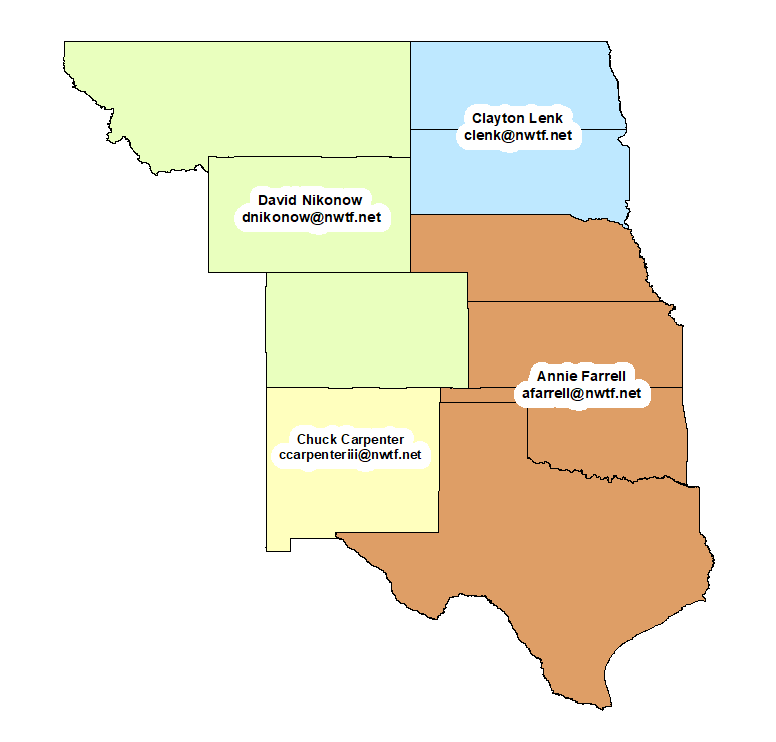Waterways for Wildlife
The Waterways for Wildlife Initiative is a comprehensive, landscape-level effort developed by the National Wild Turkey Federation to address critically urgent conservation needs in riparian ecosystems along rivers and streams in the Great Plains of the United States.
This ambitious initiative is designed to continue our efforts addressing declining riparian health in America’s Big Six of Wildlife Conservation, specifically America’s Great Open Spaces and America’s Western Wildlands.
In the arid plains of the American West, riparian areas are a natural magnet for wild turkeys and hundreds of other species of wildlife. Many of these important wildlife habitats, however, are in poor condition due to a variety of causes. To address critical conservation issues, the NWTF is partnering with landowners, governmental agencies, and other conservation organizations to restore these vitally important ecosystems across the landscape. Over the next 10 years, the NWTF will improve 75,000 acres of wildlife habitat along 1,500 linear miles of waterways in the Great Plains landscape.
What are “Riparian Areas” and why are they so important?
Commonly referred to as riparian corridors or zones, riparian areas are natural ecosystems located along the banks of rivers, streams, creeks, or any other water network.
While riparian areas make up less than 1.5 percent of the entire landscape in the Great Plains, more than 70 percent of all plains wildlife species depend on these ecosystems for water, food, cover, roosting, nesting and as travel corridors. Often described as “ribbons of life,” riparian areas support deciduous trees and shrubs in an otherwise arid and open grassland environment. Additionally, these areas provide roosting and nesting for birds, and food, cover and travel ways for a variety of animals. Riparian areas are also important for fish and other aquatic species, as they help control erosion and filter excess nutrients from surface runoff that can adversely affect spawning and rearing areas. They also serve to control flooding, improve water quality, provide for community water supply demands and recharge underground aquifers.
These functions are vitally important to the people who live on the landscape, for production agriculture, the support of local economies, jobs, hunting, fishing and in providing high quality wildlife habitats. Additionally, riparian areas provide important opportunities for family camping, hiking and bird-watching.

The Conservation Need
Riparian ecosystems are naturally diverse systems subject to frequent periods of flooding and drought. These natural disturbances serve to create new seed beds and remove biomass ultimately “setting back” plant succession, and providing nutrients to riparian plant communities which maintains a productive ecosystem that benefits wildlife species. However, many changes have occurred in the Great Plains that have disrupted this natural cycle and impacted the health of these vital communities. Land use changes (including altered hydrology), increased water demands to meet human needs, invasive species and livestock use are some of the many factors that can affect riparian ecosystem function and diminish wildlife habitat.
A Plan for Action
The NWTF is addressing the many pressing challenges in riparian areas by creating the Waterways for Wildlife Initiative. The purpose of this program is to improve the health and vigor of riparian areas on at least 75,000 acres. This ambitious plan will enhance riparian plant communities along 1,500 linear miles of rivers and streams in the American Great Plains, stretching from North Dakota to South Texas.
Strategies
Through Waterways for Wildlife, the NWTF will develop partnerships with other conservation groups, landowners and governmental agencies to develop and implement riparian enhancement projects across this landscape. Projects will focus in America’s Great Open Spaces and America’s Western Wildlands and will include:
- Fencing riparian areas to assist landowners in managing livestock access
- Planting of trees, shrubs and native grasses along riparian areas
- Removing invasive plant species that compete with important native species
- Work with others to address needed research and provide outreach and education on riparian best management practices
- Partner with others for acquisitions and easements when applicable
Waterways for Wildlife Stories
For more information about the overall initiative, contact jmcjunkin@nwtf.net.
Please use contacts from the map for region-specific information.

Your Support Makes a Difference.
CONNECT WITH US
National Wild Turkey Federation
770 Augusta Road, Edgefield, SC 29824
(800) 843-6983
National Wild Turkey Federation. All rights reserved.


